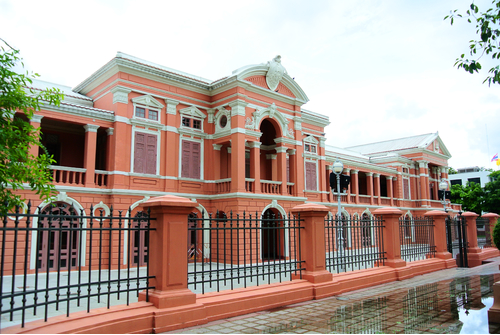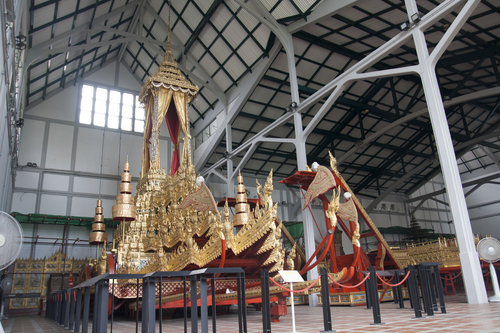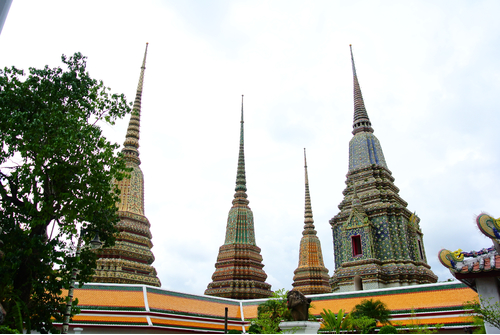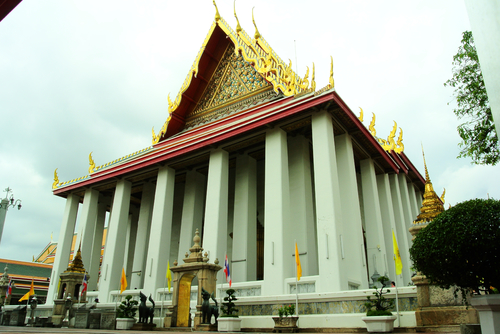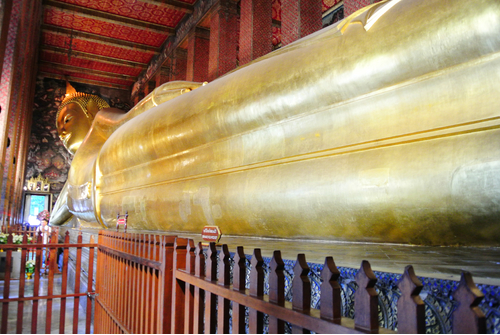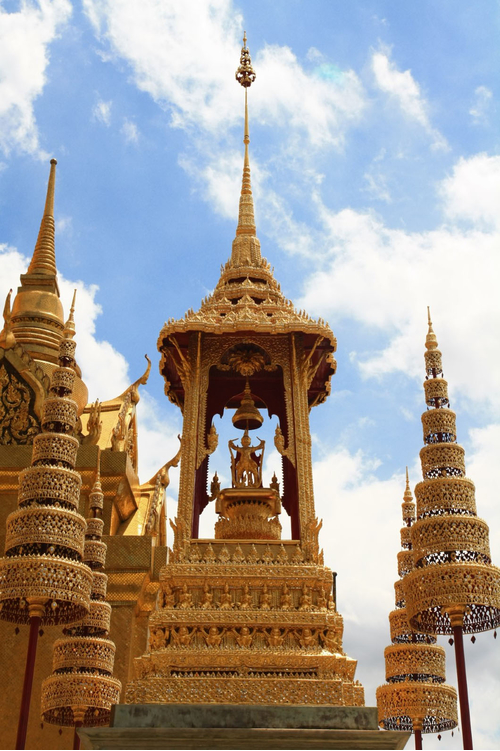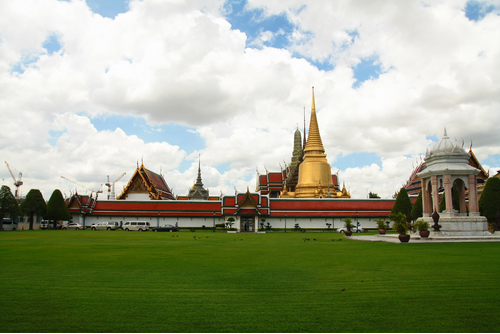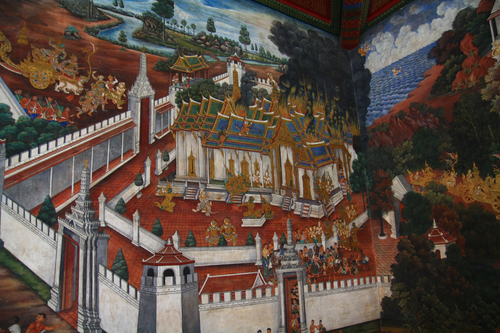ค้นหางานศิลปกรรม
ฐานข้อมูลศิลปกรรมในเอเชียตะวันออกเฉียงใต้
สถาปัตยกรรมพระราชวังสราญรมย์
พระราชวังสราญรมย์เป็นสถาปัตยกรรมแบบคลาสสิค (Classicism) ผังอาคารคล้ายอาคารสี่หลังสร้างล้อมรอบพื้นที่ตรงกลางเป็นสี่เหลี่ยมผืนผ้า โดยมีสนามอยู่ตรงกลาง ตัวอาคารด้านทิศตะวันตกซึ่งเป็นด้านหลัก เน้นความสง่างามเฉพาะด้านหน้า โดยมีแผนผังรูปตัว E คือมีมุขที่ด้านเหนือ กลาง และใต้ หน้าบันมุขเหนือและใต้เป็นรูปสามเหลี่ยมแบบวิหารกรีกประดับตาพระเกี้ยว หน้าบันมุขกลางรูปวงโค้งประดับตราพระมหามงกุฎเหนือช้างสามเศียรขนาบข้างด้วยคชสีห์และราชสีห์ หน้าบันทั้งหมดรองรับด้วยเสาโครินเธียนลอยตัวจากระเบียง มีมุขกระสันซึ่งเป็นระเบียงโปร่งเชื่อมอาคารและมุข หน้าต่างเป็นช่องสี่เหลี่ยมแคบยาวอย่างที่เรียกว่าชุดหน้าต่างพาลาเดียน (Palladian Window) รูปแบบดังกล่าวเป็นตัวอย่างสถาปัตยกรรมแบบคลาสสิคพาลาเดียนในสมัยรัชกาลที่ 5
ประติมากรรมพระมหาพิชัยราชรถ
ราชรถช่วงล่างประกอบด้วยวงล้อ 4 ล้อ ส่วนหน้ารถเรียกว่าเกริน สลักลวดลายกระหนกออกปลายรูปหัวนาค ส่วนท้ายรถเรียกว่า ท้ายเกริน สลักลวดลายกระหนกออกปลายรูปหางนาค ส่วนกลางราชรถลดหลั่นเป็นชั้นๆ แต่ละชั้นประดับประติมากรรมรูปเทพนม เหนือฐานราชรถช่วงกลางประดิษฐานบุษบกเรือนยอด เสาย่อมมุมไม้สิบสองประดับพระวิสูตรผู้ไว้ทั้ง 4 ด้าน ฐานบุษบกสลักลายประจำยามก้ามปู กระจังตาอ้อย และเทพนม หลังคาบุษบกเป็นเรือนซ้อนชั้นและมียอดแหลม องค์ประกอบทั้งหมดปิดทองประดับกระจกสี
สถาปัตยกรรมพระมหาเจดีย์สี่รัชกาล
พระมหาเจดีย์ศรีสรรเพชดาญาณ พระมหาเจดีย์ดิลกธรรมกรกนิทาน และพระมหาเจดีย์มุนีบัตบริขาร ล้วนเป็นเจดีย์ทรงเครื่องซึ่งเป็นที่นิยมในสมัยรัชกาลที่ 3 โดยเป็นรูปแบบที่สืบเนื่องมาจากศิลปะอยุธยาตอนปลาย มีองค์ประกอบที่สำคัญจากส่วนฐานได้แก่ ชุดฐานสิงห์ บัวทรงคลุ่ม องค์ระฆังเพิ่มมุม บัวทรงคลุ่มเถา ปลี ลูกแก้ว และปลียอด ประดับกระเบื้องเคลือบและกระเบื้องเครื่องถ้วยลวดลายต่างๆ โดยพระมหาเจดีย์ศรีสรรเพชดาญาณประดับกระเบื้องเคลือบสีเขียว พระมหาเจดีย์ดิลกธรรมกรกนิทานประดับด้วยกระเบื้องเคลือบสีขาว พระมหาเจดีย์มุนีบัตบริขารประดับด้วยกระเบื้องเคลือบสีเหลือง ส่วนพระมหาเจดีย์ที่รัชกาลที่ 4 ทรงสร้าง มีรูปแบบเป็นเจดีย์เพิ่มมุม ประดับกระเบื้องเคลือบสีขาบหรือสีน้ำเงิน ซึ่งเจดีย์เพิ่มมุมเป็นรูปแบบที่นิยมในสมัยอยุธยาตอนกลางเป็นต้นมา
สถาปัตยกรรมพระอุโบสถ วัดพระเชตุพนวิมลมังลาราม
พระอุโบสถเป็นอาคารก่ออิฐถือปูน เครื่องหลังคาแบบไทยประเพณี หน้าบันประดับเครื่องลำยอง ได้แก่ ช่อฟ้า ใบระกา นาคสะดุ้ง หางหงส์ ปิดทองประดับกระจก รอบอุโบสถมีเสาพาไลทรงสี่เหลี่ยมขนาดใหญ่ ไม่ประดับบัวหัวเสา พนักระเบียงรอบพระอุโบสถมีช่องสี่เหลี่ยมประดับประติมากรรมหินอ่อนแกะสลักนูนต่ำเรื่องรามเกียรติ์ บานประตูพระอุโบสถด้านนอกประดับมุกเป็นลวดลายภาพตัวละครจากเรื่องรามเกียรติ์ ด้านในเขียนลายรดน้ำรูปพัดยศพระราชาคณะ พระครูสัญญาบัตร ฐานานุกรมเปรียญทั้งฝ่ายคามวาสีและอรัญวาสีในกรุงและหัวเมือง จิตรกรรมฝาผนังภายในพระอุโบสถเหนือช่องหน้าต่างเขียนเรื่องมโหสถบัณฑิต ผนังระหว่างช่องประตูหน้าต่างเขียนเรื่องพระสาวกเอตทัคคะ บานหน้าต่างด้านในเขียนลายรดน้ำเป็นรูปตราประจำตำแหน่งเจ้าคณะสงฆ์ในกรุงและหัวเมืองสมัยรัชกาลที่ 3 ด้านนอกแกะสลักเป็นลายแก้วชิงดวง
ประติมากรรมพระพุทธไสยาส, พระพุทธไสยาสน์
พระพุทธรูปประทับนอนตะแคงขวาหรือสีหไสยาสน์ พระหัตถ์ขวาตั้งขึ้นรองรับพระเศียร โดยมีพระเขนยทรงสี่เหลี่ยมประดับลวดลายดอกไม้อิทธิพลศิลปะจีนรองรับอีกทีหนึ่ง พระพุทธรูปมีรูปแบบเป็นศิลปะรัตนโกสินทร์ กล่าวคือ พระพักตร์สงบนิ่ง พระเนตรเหลือบต่ำ พระขนงโก่ง พระโอษฐ์บางเรียว พระกรรณยาว ขมวดพระเกศาขนาดเล็ก มีอุษณีษะ และพระรัศมีเป็นเปลวเพลิง ครองจีวรห่มเฉียงเรียบ ไม่มีริ้ว จีวรบางแนบพระวรกาย มีชายสังฆาฏิเป็นแถบสี่เหลี่ยม ปลายเป็นเขี้ยวตะขาบ พาดจากพระอังสาซ้ายมาที่กลางพระอุระ ยาวจรดกึ่งกลางพระนาภี สบงมีแถบสี่เหลี่ยมยาวที่ด้านหน้าจรดข้อพระบาท และมีขอบรัดประคดฝ่าพระบาททั้ง 2 ข้าง ประดับมุกลวดลายมงคล 108 ประการ แบ่งประเภทต่างๆ ได้ดังนี้1. สัญลักษณ์แห่งโชคลาภและความอุดมสมบูรณ์ เช่น หม้อน้ำ ปลาคู่ สวัสดิกะ พวงมณี ดอกบัว เป็นต้น2. เครื่องประกอบพระบารมีของกษัตริย์และพระเจ้าจักรพรรดิ เช่น รัตนะ 7 ประการ เครื่องราชกกุธภัณฑ์ บัลลังก์ เครื่องสูง เครื่องยศ เครื่องต้นต่างๆ และราชพาหนะ เป็นต้น 3. ภาพสัญลักษณ์ภูมิในจักรวาลตามความเชื่อของพระพุทธศาสนา เช่น เขาจักรวาล มหาสมุทร ทวีปทั้ง 4 เขาพระสุเมรุ เขาสัตตบริภัณฑ์ ป่าหิมพานต์ เป็นต้น
ประติมากรรมพระบรมราชสัญลักษณ์ประจำรัชกาล
บุษบกทุกองค์ทำด้วยโลหะปิดทองประดับกระจก มีลักษณะเป็นบุษบกโถง ประกอบด้วยเสาย่อมุมทั้ง 4 มุม รับเครื่องหลังคาที่เป็นยอดแหลม ซุ้มสาหร่ายทุกด้านออกลายเทพนม ส่วนฐานบุษบกประดับชั้นเทพนมบุษบกด้านทิศเหนือประดิษฐานพระบรมราชสัญลักษณ์รัชกาลที่ 1-3 ดังนี้พระบรมราชสัญลักษณ์พระบาทสมเด็จพระพุทธยอดฟ้าจุฬาโลกมหาราช เป็นรูปพระมหามงกุฎไม่มีกรรเจียก พระบรมราชสัญลักษณ์พระบาทสมเด็จพระพุทธเลิศหล้านภาลัย เป็นรูปครุฑยุดนาค พระบรมราชสัญลักษณ์พระบาทสมเด็จพระนั่งเกล้าเจ้าอยู่หัวเจ้าอยู่หัว เป็นรูปพระวิมาน บุษบกด้านทิศใต้องค์หนึ่งประดิษฐานพระบรมราชสัญลักษณ์ พระบาทสมเด็จพระจอมเกล้าเจ้าอยู่หัว เป็นรูปพระมหามงกุฎมีกรรเจียกประดับ และอีกองค์หนึ่งประดิษฐานพระบรมราชสัญลักษณ์พระบาทสมเด็จพระจุลจอมเกล้าเจ้าอยู่หัว เป็นรูปพระจุลมงกุฎ หรือพระเกี้ยว บุษบกด้านทิศตะวันตกเฉียงเหนือประดิษฐานประบรมราชสัญลักษณ์ 4 รัชกาล ดังนี้พระบรมราชสัญลักษณ์พระบาทสมเด็จพระมงกุฎเกล้าเจ้าอยู่หัว เป็นรูปวชิราวุธ พระบรมราชสัญลักษณ์พระบาทสมเด็จพระปกเกล้าเจ้าอยู่หัว เป็นรูปพระแสงศร 3 องค์ คือ พระแสงศรพรหมาสตร์ พระแสงศรประลัยวาต พระแสงศรอัคนิวาต เหนือราวพาดพระแสงเป็นดวงตรามหาจักรีบรมราชวงศ์ภายใต้พระมหาพิชัยมงกุฎ พระบรมราชสัญลักษณ์พระบาทสมเด็จพระเจ้าอยู่หัวอานันทมหิดล พระอัฐมรามาธิบดินทร์ เป็นรูปดุสิตเทพบุตรประทับนั่งห้อยพระบาทขวาบนบัลลังก์ดอกบัว พระบรมราชสัญลักษณ์พระบาทสมเด็จพระเจ้าอยู่หัวภูมิพลอดุลยเดช เป็นรูปพระที่นั่งอัฐทิศอุทุมพรราชอาสน์ มีอุณาโลมล้อมด้วยจักรและรัศมีอยู่เหนือพระที่นั่ง ด้านบนมีพระนพปฎลมหาเศวตฉัตร พระบรมราชสัญลักษณ์ทั้งหมดประดิษฐานภายในบุษบกเหนือฐานหินอ่อน รอบฐานมีประติมากรรมรูปช้างทำด้วยสำริด หมายถึงพระยาช้างเผือกและช้างสำคัญในรัชกาลนั้นๆ
สถาปัตยกรรมวัดพระศรีรัตนศาสดาราม
พระอุโบสถวัดพระศรีรัตนศาสดารามเป็นอาคารแบบไทยประเพณีก่ออิฐถือปูน เครื่องหลังคาทำด้วยไม้มุงกระเบื้องเคลือบสี หลังคาซ้อนชั้น หน้าบันเป็นไม้แกะสลักรูปพระนารายณ์ทรงครุฑ ปิดทองประดับกระจก ประดับด้วยช่อฟ้า ใบระกา นาคสะดุ้งและหางหงส์ มีเสาพาไลที่เป็นเสาย่อมุมปิดทองประดับกระจก มีบัวแวงประดับหัวเสา และมีคันทวยรองรับชายคา ผนังภายนอกพระอุโบสถปิดทองประดับกระจกสีเป็นลายพุ้มข้าวบิณฑ์ภายในพระอุโบสถ ประดิษฐานพระพุทธมหามณีรัตนปฏิมากรบนบุษบกสูง ที่ด้านหน้ายังมีพระพุทธรูปสำคัญอีกหลายองค์ เช่น พระพุทธยอดฟ้าจุฬาโลก พระพุทธเลิศหล้านภาลัย พระสัมพุทธพรรณี เป็นต้น ที่ฝาผนังภายในพระอุโบสถเขียนภาพจิตรกรรมเรื่องไจรภูมิโลกสัณฐาน พุทธประวัติ และกระบวนพยุหยาตราทางชลมารคและสถลมารค สถาปัตยกรรมที่สำคัญอื่นๆ ภายในวัด เช่น บริเวณด้านทิศเหนือของพระอุโบสถเป็นฐานไพทีสูง ประดิษฐานพระศรีรัตนเจดีย์ มีรูปแบบเป็นเจดีย์ทรงระฆังซึ่งถ่ายแบบมาจากเจดีย์ประธานของวัดพระศรีสรรเพชญ ประดับด้วยกระเบื้องสีทองตลอดทั้งองค์ ถัดมาเป็นพระมณฑปประดิษฐานพระไตรปิฎก อาคารอยู่ในผังสี่เหลี่ยมจัตุรัส หลังคาซ้อนชั้นเป็นทรงกรวยยอดแหลม ที่บานประตูประดับมุก มียักษ์ทวารบาลที่ด้านหน้า บันไดทางขึ้นประดับด้วยนาคที่มีหน้าเป็นมนุษย์ ถัดมาคือปราสาทพระเทพบิดรซึ่งมีรูปแบบเป็นอาคารทรงปราสาทจตุรมุขที่มียอดปรางค์ หน้าบันทั้ง 4 ประดับตราพระบรมราชสัญลักษณ์ในรัชกาลที่ 1-4 บานประตูหน้าต่างประดับตราพระบรมราชสัญลักษณ์ในรัชกาลที่ 1-5 ภายในประดิษฐานพระบรมรูปพระมหากษัตริย์รัชกาลที่ 1-8
จิตรกรรมจิตรกรรมฝาผนังเรื่องรามเกียรติ์
จิตรกรรมแบบไทยประเพณีผสมผสานกับเทคนิคการเขียนภาพแบบสมัยใหม่ ลักษณะที่แสดงถึงความเป็นจิตรกรรมไทยแบบประเพณี ได้แก่ ภาพบุคคลในเรื่องที่เป็นตัวละคนสำคัญแต่งกายยืนเครื่องเช่นเดียวกับการแต่งกายในการแสดงโขน กิริยาอาการอยู่ในท่านาฏลักษณ์ มีการปิดทองคำเปลวที่เครื่องทรงของตัวละครที่สำคัญ เป็นต้น ส่วนเทคนิคการเขียนภาพแบบใหม่ที่แตกต่างจากจิตรกรรมไทยประเพณี ได้แก่ การกำหนดเส้นขอบฟ้าและวางระยะของวัตถุในภาพทำให้เกิดมิติ การเขียนภาพเหมือนของอาคารสถานที่ที่มีอยู่จริง เช่น พระมหาปราสาทในพระบรมมหาราชวัง และการเขียนภาพทิวทัศน์ต่างๆ อย่างเหมือนจริง นอกจากนี้ ยังมีการสอดแทรกเรื่องราววิถีชีวิตชาววัง ชาวบ้าน และอารมณ์ขันต่างๆ ผ่านตัวละครประกอบของเรื่อง จิตรกรรมฝาผนังมีทั้งสิ้น 178 ห้องภาพ ใต้ภาพมีโคลงเรื่องรามเกียรติ์ประกอบ รวมทั้งสิ้น 224 บท
